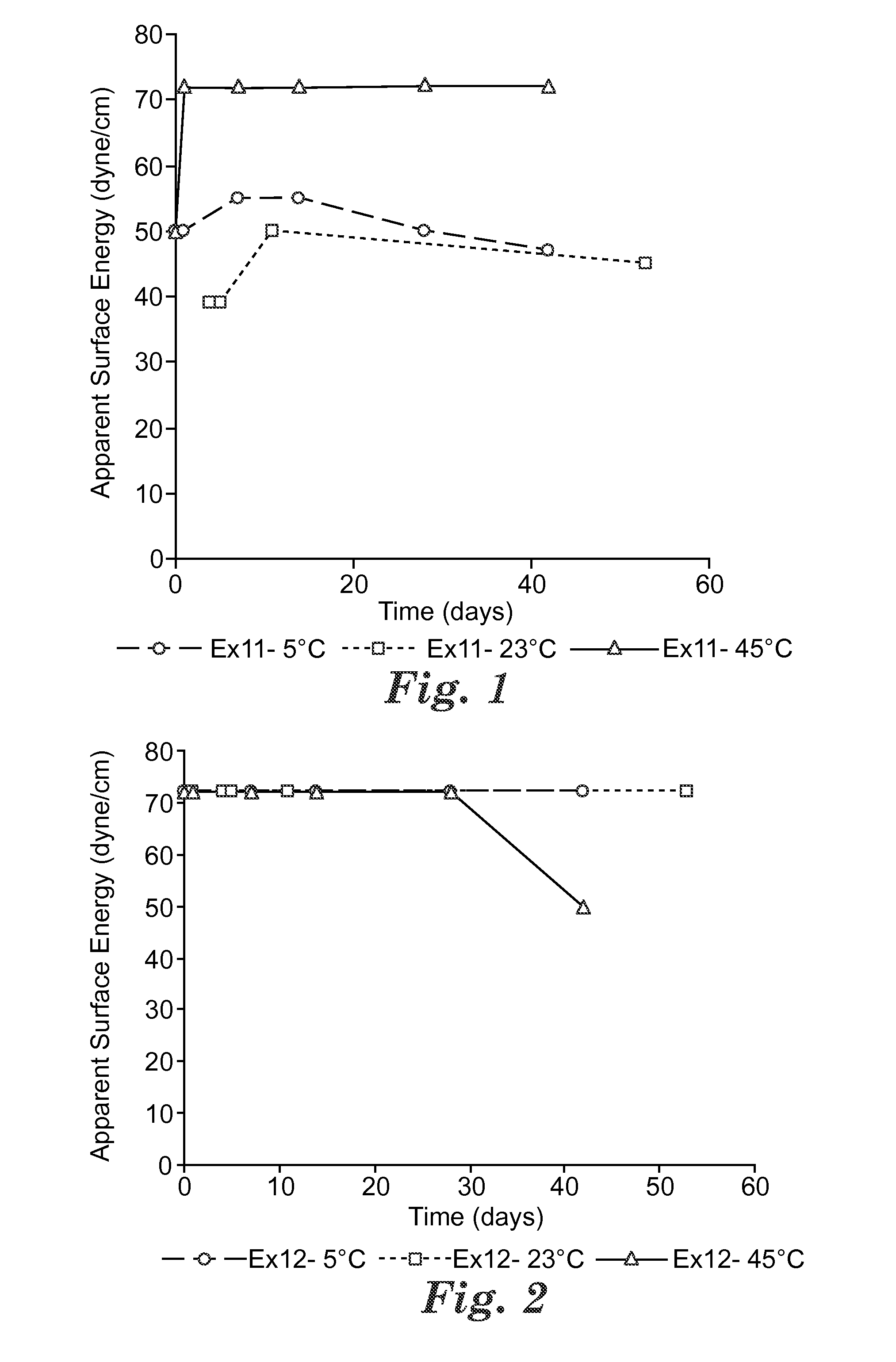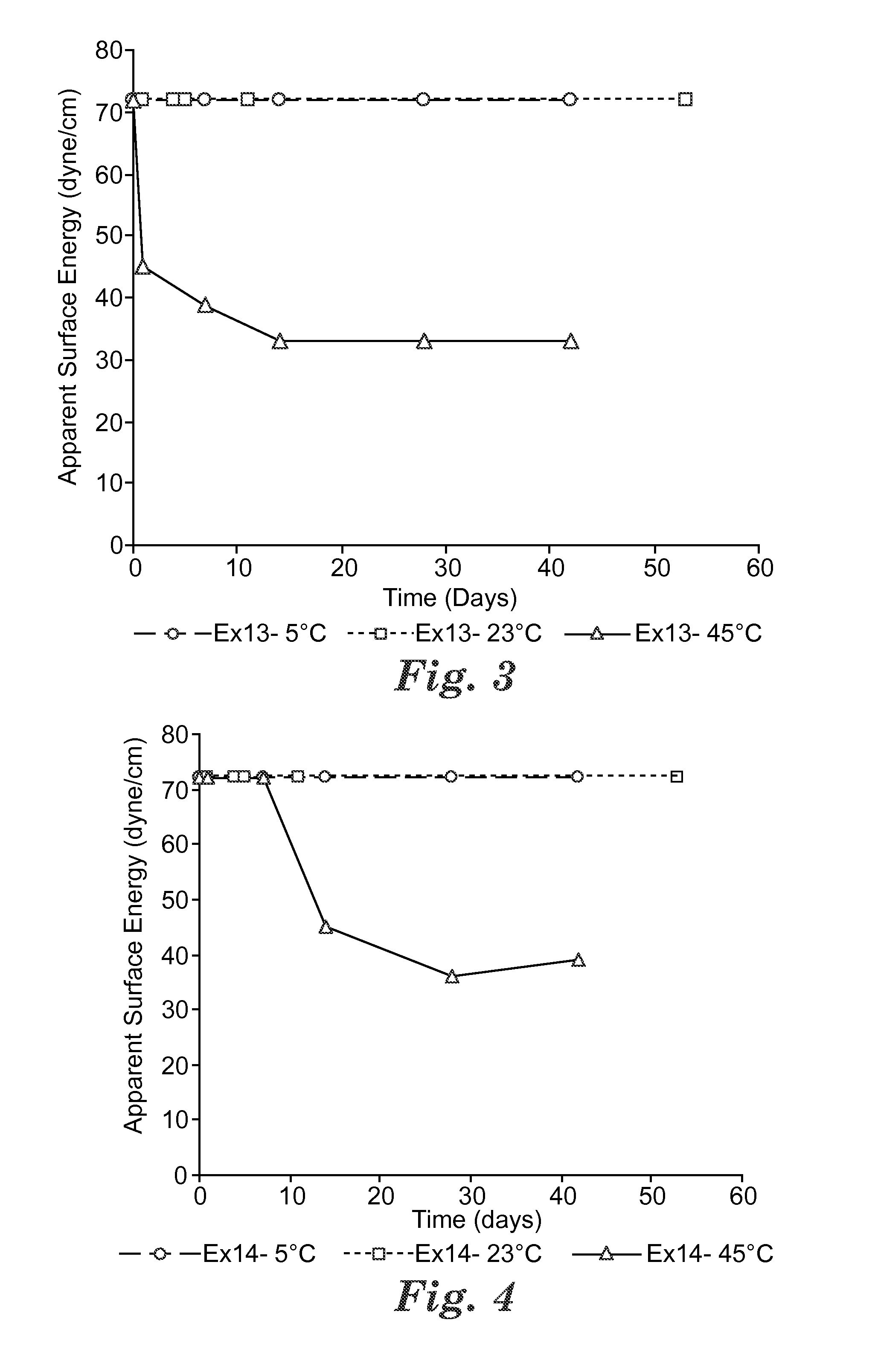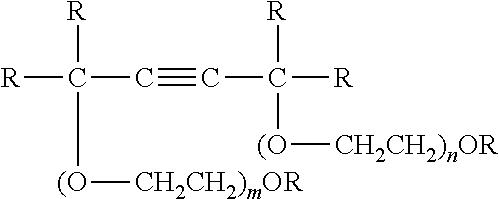Hydrophilic polyproylene melt additives
a polypropylene and additive technology, applied in the direction of chemical/physical processes, textiles and papermaking, nonwoven webs, etc., can solve the problems of high cost, time-consuming, and high cost of coating preparation, and achieve stable, durable hydrophilicity to thermoplastic polymers, and low cost.
- Summary
- Abstract
- Description
- Claims
- Application Information
AI Technical Summary
Benefits of technology
Problems solved by technology
Method used
Image
Examples
examples
Apparent Surface Energy Test Method:
[0113]The method for measuring the surface energy is AATCC Test Method 118-1983, with the modifications described below. Surface energies measured according to this modified test method are hereinafter referred to as “apparent” surface energies. AATCC test method 118-1983 determines the surface energy of a fabric by evaluating the fabric's resistance to wetting by a series of selected hydrocarbon compositions. The hydrocarbons set forth in AATCC 118-1983, however, only provide for measurements of surface energy from about 19.8 to 27.3 dynes per centimeter at 25° C. This range is extended by employing various mixtures of methanol and water in the fabric resistance test. The compositions and their representative surface tensions are presented in Table 1.
TABLE 1Volume %Surface TensionLiquid No.Methanol / Water(dynes / cm at765 / 4530853 / 4735940 / 60401025 / 75451121 / 79501215 / 855513 8.5 / 91.560
[0114]The test procedure is as follows. A specimen of the example mat...
control examples 1-5
[0116]Spunbond type nonwoven examples were prepared using the masterbatches blended with neat polypropylene. The polypropylene used is indicated below. The masterbatch materials were dried prior to use.
[0117]The spunbond nonwovens were obtained using a Davis-Standard BLUE RIBBON (DS-25®) extruder (Davis Standard Corporation, Pawcatuck, Conn.) using a 2.5 inch (63.5 mm 3:1 compression ratio barrier flight single screw extruder to feed through a pump to an extrusion head including multiple die orifices.
[0118]The die head had a total of 512 orifice holes with a throughput of 0.50 g / hole / min (33.83 lb / hr). The die had a transverse length of 7.875 inches (200 mm). The hole diameter was 0.020 inch (0.445 mm) and L / D ratio of 6. The melt extrusion temperature at the die of the neat polypropylene was set at 235° C., while the melt extrusion temperature of polypropylene with the additives was dependent on the type and amount of additives. The temperature was adjusted in order to make similar...
examples 6-14
[0121]The raw materials listed in Examples 1-5 were used to make the compositions listed in Table 5, according to the procedure of Examples 1-5. Table 5 also describes the initial wetting results obtained using water on the roll as it was winding up. Only Examples 8, 10, 12-14 showed instantaneous wet out on the machine as it was being produced.
TABLE 5Use of TPM 12713 R-PEG in Combinationwith Polybutylene and R-SO3 SurfactantTechmerHostastatPoly-12713HS1butyleneFCS-1,Initial Water WettingEx.(Wt %)(Wt %)(Wt %)(Wt. %)Results:64040No wetting.74440Some absorbent spots.84460Very rapid, sponta-neous wetting.90460No spontaneous wet-ting on roll; repellent.102460Very rapid, sponta-neous wetting.114080Does not wet wellon roll.120442Instantaneous wet-ting on roll.Very absorbent.134600Some absorbency onroll. After a fewhours it wets withgreat absorbency.140402Wets out very wellon roll and post.
[0122]The webs produced were tested for Apparent Surface Energy as a function of time at 5° C., 23° C...
PUM
| Property | Measurement | Unit |
|---|---|---|
| Percent by mass | aaaaa | aaaaa |
| Percent by mass | aaaaa | aaaaa |
| Percent by mass | aaaaa | aaaaa |
Abstract
Description
Claims
Application Information
 Login to View More
Login to View More - R&D
- Intellectual Property
- Life Sciences
- Materials
- Tech Scout
- Unparalleled Data Quality
- Higher Quality Content
- 60% Fewer Hallucinations
Browse by: Latest US Patents, China's latest patents, Technical Efficacy Thesaurus, Application Domain, Technology Topic, Popular Technical Reports.
© 2025 PatSnap. All rights reserved.Legal|Privacy policy|Modern Slavery Act Transparency Statement|Sitemap|About US| Contact US: help@patsnap.com



